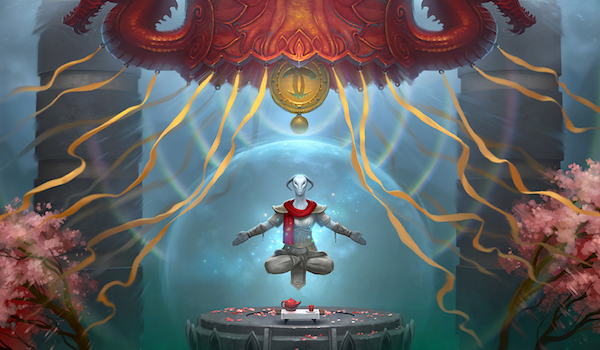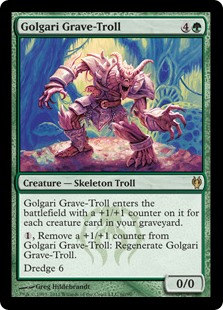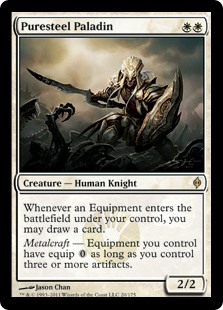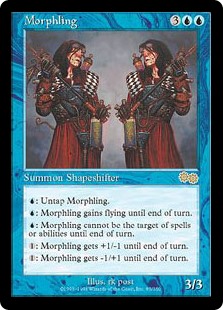Are you a Quiet Speculation member?
If not, now is a perfect time to join up! Our powerful tools, breaking-news analysis, and exclusive Discord channel will make sure you stay up to date and ahead of the curve.
Since the Golgari Grave-Troll banning, the Modern banlist hasn't been updated. But the format has changed dramatically, welcoming Fatal Push into its upper crust and appropriating Death's Shadow for a Probeless era. Of course, the format's recent stability hasn't stopped detractors from clamoring for bans or unbans. Today, we'll explore what makes a format healthy, and why the notion of metagame health is so emblematic of Modern.

 The Meaning of Health
The Meaning of Health
Many discussions about format health are rife with miscommunication. The reason? Everyone has their own definition of "health." For many, health relates directly to one's own preconceptions regarding deck diversity, archetype balance, fairness, and fun. Since each player is bound to hold unique opinions on such topics, I'm skeptical of discussions based around them. Rather, grasping and dissecting Wizards of the Coast's understanding of "health" stands to yield far more productive results, as that understanding allows us to accurately predict banlist announcements.
Modern Health
Fortunately, we know quite a bit about Wizards's views on the subject. In a game-changing mothership article last year, Sam Stoddard outlined some guidelines for Modern metagame health. He claimed that Modern should:
- Have a diverse top-tier metagame featuring over a dozen archetypes.
- Not be dominated by fast, non-interactive decks (consistent kills before turn four are a red flag).
- Be at a power level that allows some newly printed Standard cards to affect the format (we don't have other ways to introduce cards into the format, and we like it when cards or decks can transition).
- Have as small a banned list as possible that accomplishes all the previous goals.
Let's break down these points one by one.
It shouldn't come as a surprise that first on the list is diversity. Since there are only so many strategic archetypes (control, combo, tempo, etc.), I think it's safe to assume Stoddard is using the word to refer to broad labels for unique strategies (i.e. Death's Shadow Aggro, BGx Midrange, etc.). Modern can't be diverse if one deck consumes too much metagame share, so it makes sense to ban cards from decks that fit that description. Based on Wizards's Jund bans, it seems that the cut-off for over-dominance hovers between 12% and 20%—decks this popular should set off alarms. The number gets lower for decks that violate Wizards's format guidelines in other ways (see: Twin).
Next up is the Turn Four Rule. This one is pretty straightforward, so long as the meaning of the Turn Four Rule isn't lost in the fact that it contains the words "turn" and "four" (faulty grounds for confused players to claim any deck that can win before turn four should crumble under the hammer).
 Third, Wizards wants Standard cards to enter Modern with relative frequency. An example of how this goal might apply to a banlist decision: having cards like Jace, the Mind Sculptor legal sets the bar very high for planeswalker viability, and might keep otherwise fine walkers from seeing Modern play. And a less controversial one: having Golgari Grave-Troll legal makes Dredge so consistent that it becomes incorrect to play other graveyard decks, invalidating delirium and many other graveyard-based mechanics Wizards might roll out through Standard.
Third, Wizards wants Standard cards to enter Modern with relative frequency. An example of how this goal might apply to a banlist decision: having cards like Jace, the Mind Sculptor legal sets the bar very high for planeswalker viability, and might keep otherwise fine walkers from seeing Modern play. And a less controversial one: having Golgari Grave-Troll legal makes Dredge so consistent that it becomes incorrect to play other graveyard decks, invalidating delirium and many other graveyard-based mechanics Wizards might roll out through Standard.
The final point is more about "banlist health" than format health, so we'll table it for now.
More recently, and absent from this list of bullet points, is another guideline: Wizards has expressed interest in improving Modern's color diversity (presumably by throwing a bone to either blue or white decks).
When considering Wizards's views of the format, it becomes imperative to refer to the above points. Whether a card, deck, or decision is "healthy" for the format, according to Wizards, depends on its adherence to these values.
The Eternal Double Standard
The above guidelines refer to Modern, and to Modern only. I often see players comparing Modern to Legacy, either to annoyedly wonder why Wizards doesn't let Modern self-regulate in a similar way or to admire Legacy's wealth of viable decks. Besides the fact that Modern lacks self-regulation tools like Force of Will and Wasteland, and therefore needs banlist assistance to address issues like Eye of Ugin Eldrazi or Grave-Troll Dredge, Wizards clearly has very different goals for that format. Miracles took up 20% of the metagame for over a year before Sensei's Divining Top was finally banned. That would never happen in Modern.
As for viable decks, how many can there really be if the top decks are allowed to hold such large share portions? I think Legacy is so "diverse" because people play with the decks they've had forever and the cards they like, no matter how good or bad they are. There's more on the line when it comes to Modern, a format supported by Wizards and other tournament organizers at high levels of competition. I think it's best to keep the Legacy comparisons out of discussions on Modern's health.
Modern's Divisive Nature
More than any other non-rotating format, Modern frequently inspires heated debates about format health. We're currently coming out of Modern's infancy, a period in which Wizards guided the format's evolution with a steady hand. Now that Modern has caught on with the players, the company will recommit to Standard, its primary cash cow. But the effects of the company's diligent Modern-shaping linger on, inciting ban-mania whenever the format shifts.
This ban-mania is invariably linked to one of two recurring player gripes with Modern: the abundance of linear decks, and the distinct lack of a top-tier Weissman deck.
Lots of Linear
 It seems whenever a new deck breaks out at a streamed tournament, ban-mania consumes the online Modern community. Or does it? When Bant Eldrazi, Death's Shadow Jund, or, most recently, the Vizier of Remedies-featuring Abzan Company enjoyed a string of favorable results, the ban-mania crowd proved mostly silent. Indeed, it seems this crowd only rears its ugly head when linear decks have good tournaments.
It seems whenever a new deck breaks out at a streamed tournament, ban-mania consumes the online Modern community. Or does it? When Bant Eldrazi, Death's Shadow Jund, or, most recently, the Vizier of Remedies-featuring Abzan Company enjoyed a string of favorable results, the ban-mania crowd proved mostly silent. Indeed, it seems this crowd only rears its ugly head when linear decks have good tournaments.
If Cheeri0s, Grishoalbrand, Lantern Control, and other such linear decks reliably inspire a knee-jerk descent into ban-mania after an impressive game on stream, we'd do well to know why. I think a few factors are at play here.
First, these decks simply do more broken-looking things than most interactive decks can muster. Tarmogoyf will never kill on turn two; Puresteel Palladin will. Pundits imprudently cite Modern's notoriously perplexing Turn Four Rule to defend calls to axe Sram, Senior Edificer, Nourishing Shoal, or any other key component of a linear deck that doesn't come close to having enough of a meta share to actually deserve a banning.
Realistically though, these decks give up interactivity and consistency points to achieve their occasional explosiveness. If they didn't, they'd be stronger decks; more people would play them, and they'd put up the kinds of numbers that might actually spur Wizards into action.
Second, Modern is a format principally defined by proactivity. Some players, especially ones that favor reactive strategies, take issue with this predicament. For them, decks that exemplify that proactivity-first credo—combo decks—represent fundamental issues with the format.
Now, think back to Death's Shadow Jund. Here's a deck that had a phenomenal breakout weekend, was heralded as the "best deck in Modern" by pros who gushed about it for weeks, handed an Open win to Austin Bursavich, who hadn't played constructed Magic in years and missed several Bauble triggers, and continues to put up impressive numbers by any standard. And yet, no ban-mania! Death's Shadow strategies are chock-full of interaction, and despite their reversibility, are about as fair as aggro decks can get in Modern. It's the format's linear decks that create ban-mania.
Muh Serra Angel
 Another recurring theme with banlist discussion is players' fixation on having a Weissman, or "pure control" deck in Modern's top tier. Modern has plenty of control hybrids available, ranging from tempo to midrange to prison. But for some reason, a small, vocal subset of players won't settle for anything less than a style of deck that hardly even exists in other formats anymore.
Another recurring theme with banlist discussion is players' fixation on having a Weissman, or "pure control" deck in Modern's top tier. Modern has plenty of control hybrids available, ranging from tempo to midrange to prison. But for some reason, a small, vocal subset of players won't settle for anything less than a style of deck that hardly even exists in other formats anymore.
To these players, I ask: why should Weissman be a top-tier Modern deck? One could make the argument that it provides yet another archetype, and therefore increases diversity. But the hoops Weissman has to jump through to become a major player in Modern are enormous, which explains why it hasn't done well in years, despite Modern shifting often and deeply. Wizards would need to somehow sneak less-conditional countermagic, more efficient card draw, and a reliable way to beat ramp decks (question mark) into the format without ruining Standard, and it seems they're yellow to.
Also of note: for all the doomsaying, Snapcaster Mage is currently Modern's fifth-most-played creature, beating out Thought-Knot Seer and even Death's Shadow.
The State of the Format
So, how's Modern doing? From here, the format looks great. Not one deck even cracks 8% on MTGGgoldfish; the format's best deck is firmly midrange, not combo; and Standard cards as innocuous as Vizier of Remedies continue to pop up and make waves. Blue and white do continue to struggle relative to the other three colors, making me think now's perhaps as good a time as any for an unban. Wizards has always waited for periods of relative stability and health (in their eyes—in other words, the kind of health we just spent the article defining) to release cards back into Modern, and I wouldn't be surprised if something like Stoneforge Mystic came off this time around.




With respect to GGT, I strongly believe that Narcomoeba should have gotten the axe instead. That’s the problem card with dredge, by allowing too much “free stuff.” With ‘moeba gone, GGT serves as a healthy enabler to other valid GY strategies (see: Vengevine) that still force players to have lands and cast spells using actual mana (Bloodghast is noted).
Dredge is the actual mechanic that Wizards doesn’t like though, and GGT was basically in trial-period mode going by their banlist announcements. Besides, they didn’t want to kill the deck or deeply alter it, but to slow it down by a turn or so. They do that with nearly every deck they ban—Bloom becomes Azusa, Temple + Eye becomes only Temple, etc. Pundits might point out that Twin was “totally killed,” but if you read their announcement, they cite Kiki-Jiki as a one-mana-more replacement, so they had the same intention with that decision (even though things didn’t quite work out the way they’d hoped).
I quite liked the GGT ban because it was so in line with how Wizards has historically managed the Modern banlist and was thoroughly explained.